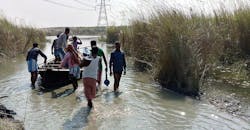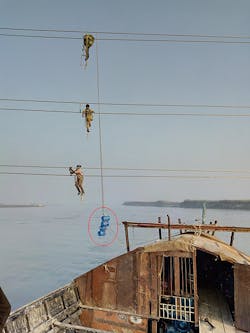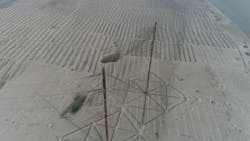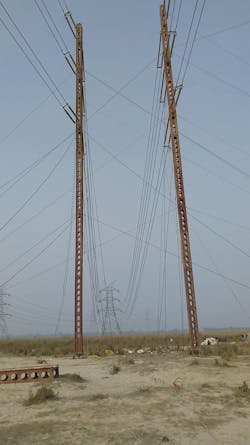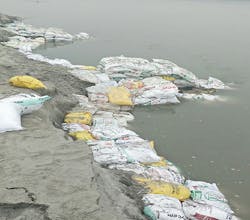Temporary Transmission Towers to Minimize Interruption of Power Supply
The most important function of an overhead transmission line is to provide a continuous and reliable source of electrical energy. However, on occasion, overhead lines can fail as a result of severe weather conditions and natural disasters. Earthquakes, floods, landslides and hurricanes can push a line’s design limits beyond its standards. The failure of overhead line transmission towers can result in major power interruptions, inflicting significant financial damage on customers, utilities and generating plants. It is prudent and necessary for transmission system operators (TSOs) to take the necessary precautions to avoid and minimize interruptions of power supply from extreme weather events.
When a major event occurs, utilities and TSOs often are obliged to erect temporary transmission towers designed to bypass existing damaged transmission towers in any terrain and operate at the design voltage of the damaged circuit. Moreover, temporary towers also are used occasionally to aid in the construction of refurbishing an existing transmission line, for example, with new conductors and insulators. These temporary towers remain on-site until failed towers are replaced, conductor restringing is completed and the circuit is recommissioned in its original condition. The temporary tower structure then can be disassembled.
The primary vendors for temporary towers are based in Canada and the U.S. Their principal customers are utilities with large transmission systems, inventories and a dedicated overhead line team trained to erect the towers when needed. Generally, these vendors are out of bounds for many smaller utilities that have periodic outages as a result of tower failures and overhead line reconductoring projects. The cost of importing these structures is significant, including for Indian utilities. Then there is the expensive life-cycle cost of procuring, developing, training and maintaining a team that can support the temporary towers.
Another Option
A new vendor in India, Supreme & Co. has taken this marketing opportunity to design and manufacture emergency restoration structures (ERS) using high-strength steel. The fully standardized fabrication process of steel has made the ERS manufacturing process an economical, functionally reliable and structurally stable option. The ERS is designed and manufactured in such a way the complete structure can be erected in a few hours.
Tower sections are modular and compact for ease of transportation to sites in remote locations. Civil foundations are not needed and erection is simplified with the use of a gin pole, which obviates the need for heavy large machinery. Use of composite insulated crossarms reduces the load on the structure and the clearances required for conductor stringing.
The temporary towers are supported entirely by guy wires, which all must be anchored properly to the soil. The design team developed a range of different anchors to support a structure in various soil conditions. The towers are temporary structures designed to bypass existing high-voltage (HV) and extra-high-voltage (EHV) transmission lines in any terrain to restore power supplies following an outage or when the transmission line is being reconductored. A relatively short outage time is required to transfer the transmission line overhead conductors to the temporary tower, so the savings attributable to reduced outage time far outweighs the cost of the temporary towers.
Tower Application
To address India’s increasing demand for electrical energy, utilities now are uprating their existing overhead transmission lines by reconductoring. This can be problematic because of the long-term shutdown required for reconductoring the invariably overloaded circuits. It requires the extensive use of temporary towers.
Following a monsoon in 2017 that caused severe flooding, the 400-kV HV double-circuit Barh-Motihari overhead transmission line, which crosses the Gandak River in the Bihar State in India, experienced a tower structure failure. The transmission line supplied 700 MW to a large community, so it was essential the power supply be restored urgently. The utility opted to use temporary towers to restore the supply until a permanent replacement 400-kV transmission tower was installed. As the cost of importing temporary towers was prohibitive and would take several months, the utility decided to look for a temporary tower manufactured in India.
The utility approached Supreme & Co. about its temporary tower solution. Based on results the utility had with the manufacturer on two previous projects, Supreme & Co. was awarded a contract for the 400-kV HV double-circuit transmission line restoration work.
Previous Projects
The first project with Supreme & Co. was to bypass and change the route of a 132-kV transmission line to facilitate the construction of a nearby flyover. The line was serving a large population, so arranging a shutdown to bypass the line would be difficult. A line length of 1800 m (5906 ft) was bypassed using temporary towers routed through a residential and well-developed commercial area. This was the first ever bypass arrangement on a HV transmission line in India using Indian-manufactured temporary towers.
The second project was to bypass a 132-kV transmission line, which was preventing the completion of a 400-kV transmission line project. This challenging project involved a flyover as well as river and highway crossings. The project was executed in four days with a transmission line shutdown of four hours, causing no disruption to highway traffic.
Barh-Motihari Challenges
Following a site survey, the utility planned a restoration project to transfer the existing 400-kV double-circuit line to three temporary towers, each of which used two towers, thereby forming a double circuit.
Access was a construction challenge, as there was no road access to the site. The line survey and even transportation of materials to the site had to be done using rowboats. Rowing the boat with tower materials was made more difficult because of the strong river currents. Another challenge was positioning the temporary towers. The river crossing span was too long, and it proved necessary to install a temporary tower in the river. Fortunately, the survey team found a sand dune in the middle of the river, which was used to install the tower.
The real challenge started at the time of installing the anchors, as the soil was sandy and not suitable for installing any type of anchors. Modular supports were specially designed for this, considering the guy angles and ease of transport. The long modular steel supports offered the large width necessary for connecting the guy wires and increasing the stability of a temporary tower.
Conductor stringing across the river with a fast water current was the next challenge. The overhead line construction team had to ensure the conductor was not immersed in the river, as it could add extra load on the conductor during stringing. Pulling the conductor through the heavy river current would have stressed the tower severely. To avoid this issue, water cans were tied to the conductor so it would float.
Only tension temporary towers were installed to reduce the sag and obtain the required vertical conductor clearance over the river. Furthermore, long rod insulators of 160 kN were used for attaching the guy wires to ensure the required clearance was met between the phase conductors and guy wire. The embankment was made more permanent using sandbags to prevent erosion. As the towers had to remain in position for six months, local people saw this as an opportunity to start cultivating crops on the sand dune.
After overcoming these challenges, the 400-kV double-circuit Barh-Motihari overhead transmission line was reenergized in January 2018 using the ERS. Without temporary tower use, the prolonged outage of the 700-MW load-transfer facility would have resulted in a serious economic loss to the utility and its customers.
Acknowledgement
The author thanks Harish Agarwal, Pradip Barua, Arup Das and Kumaran Ramadass of Supreme & Co. for their technical contribution and support given to the preparation of this article.
For more information:
Supreme & Co. | www.supreme.in
About the Author
Nimish Sheth
Nimish Sheth has almost 30 years of experience in power systems, including power projects, electrical installations, transmission and substation construction, project and risk management. Currently employed by Essel Infraprojects, Sheth leads transmission projects throughout India and is responsible for operations and maintenance (O&M) commissioned projects. He also has experience in procurement, contract management, business process reformation and information technology integration for large-scale projects.
